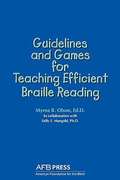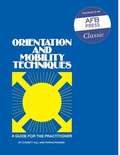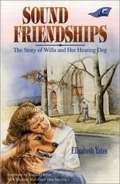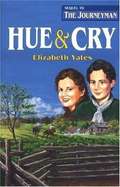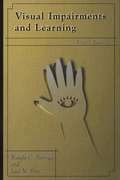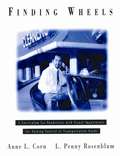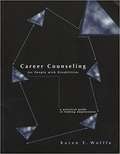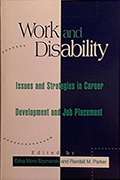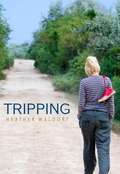- Table View
- List View
The Future of Work for Disabled People: Employment and the New Technology
by Ian Morris Wassily Leontief Walter Y. Oi William F. Gallagher Curt Tausky Timm Kainen Lawrence A. Scadden William J. Dennis Dennis Chamot Jesse M. Smith Erich Bloch Joseph F. CoatesThis important book, by an impressive and talented team of authors, will help us plan to ensure that workers with disabilities find their rightful place in the workplace of the future.
Foundations of Education for Blind and Visually Handicapped Children and Youth Theory and Practice
by Geraldine T. SchollBlind children -- Education. Children with visual disabilities -- Education.
Piagetian Reasoning and the Blind
by Yvette HatwellThe book reports the results of a series of studies undertaken in the early 1960s on the cognitive development of children with congenital blindness.
Understanding Low Vision
by Randall T. JoseTextbook on assessment of low vision, clinical services, training and instructional services, and special considerations.
Recreation Programming for Visually Impaired Children and Youth
by Jerry D. KelleyThe book is designed primarily for the recreation consultant or trainer concerned with assisting the community recreation leader in his or her efforts to provide recreation programs and services for the visually impaired child.
Guidelines and Games for Teaching Efficient Braille Reading
by Myrna R. Olson Sally S. MangoldThese unique guidelines and games provide ideas for adapting a general reading program to the needs of braille readers and enriching early instruction in braille that are based on research in the areas of rapid reading and precision teaching. Classroom teachers and anyone working with children who are blind or visually impaired will find this classic handbook an invaluable resource.
Berthold Lowenfeld on Blindness and Blind People: Selected Papers
by Berthold LowenfeldThis book contains articles spanning a period of almost 40 years by Dr. Berthold Lowenfeld, a creative writer in education of the visually handicapped on Blindness and Blind People.
The Demography of Blindness Throughout the World
by Hyman Goldstein<P>Most of the world's blindness could be prevented, and the attack on it and its consequences proceeds apace through such organizations as the World Council for the Welfare of the Blind, the International Agency for the Prevention of Blindness, and the World Health Organization. <P>For greatest effectiveness, their programs must be based upon accurate data, as a WHO study quoted here by Dr. Goldstein makes clear: "In order to establish appropriate priorities for prevention and treatment at the national and international level, it is essential that reliable up-to-date statistical data on prevalence, age of onset, and causes of blindness be obtained." <P>But even in the United States, where collection of data on blindness began in 1830, there are still no reliable trend data. In much of the rest of the world data are fragmentary, and data that would allow valid country by country comparisons are almost non-existent. <P>Dr. Goldstein has done a valuable service in pulling together such statistics as can be found, and in discussing their weaknesses and strengths.
Living with Impaired Vision: An Introduction
by Anne Yeadon Dava GraysonBlind and visually impaired people: active, concerned about their jobs, their families, their communities, obtaining a good education, discovering interesting ways to use their leisure time, and above all, as different from one another as any other group of people who happen to have one characteristic in common. Today there are visually impaired people in every major area of employment from professional occupations to technical and clerical work. There are blind lawyers and college professors and insurance salesmen and social workers, blind typists and switchboard operators, auto mechanics and chemical engineers.
Competency Based Curriculum for Teachers of the Visually Handicapped
by Susan J. SpunginThis book is a guideline for teachers of the blind. Six basic types of education system now exist, and were examined for the purposes of this study: full-time special class, resource room, itinerant program, resource room/itinerant program, teacher consultant, and residential school.
An Introduction to Working with the Aging Person Who Is Visually Handicapped (2nd edition)
by Dava GraysonThis book deals with aged blind persons, the ways and means of lending them a helping hand, services available to them, and solving other problems.
Orientation and Mobility Techniques: A Guide for the Practitioner
by Everett W. Hill Purvis PonderA large-format manual covering definitions, techniques, and devices, designed for administrators, educators, rehabilitation counselors, and other professionals concerned with the mobility training process. A classic compilation of information on an essential subject.
Orientation and Mobility Techniques
by Everett Hill Purvis PonderA reference for professional mobility instructors of the techniques developed during the past 30 years.
Language Instruction for Students with Disabilities (3rd edition)
by Edward A. Polloway Lynda Miller Tom E. C. SmithLanguage development and language competence are recognized as critical emphases in the education of all children, and certainly those who experience disabilities. The substantial amount of research and programming in the diverse fields within the language domain reflects this emphasis.
The Handicapped in Literature: A Psychosocial Perspective
by Eli M. BowerThe way to understand the nature of the special education task is to know the children and youth. One excellent way to know them is to experience their lives, drawn taut by the sensitivity and insight of the literary masters. That is the "why" of this book. It does not stop with information; it arouses and activates empathic feelings for handicapped.
Sound Friendships: The Story of Willa and Her Hearing Dog
by Elizabeth YatesFrom the book Jacket: Sound Friendships is the story of Willa Macy, who lost her hearing when she was fourteen years old, and Honey, a golden retriever, who helped her to discover a new world of independence and security. It is also a story about Hearing Dogs-their background, training, special abilities, and the unique relationship they develop with their owners in working to surmount the barriers of a physical handicap.
Hue & Cry
by Elizabeth YatesJared Austin, staunch member of the mutual protection society that defends his 1830s New Hampshire community against thieves, tries to temper justice with mercy when his deaf daughter Melody befriends a young Irish immigrant who has stolen a horse.
Visual Impairments and Learning
by Natalie C. Barraga Jane N. ErinNew ways of thinking about individuals with visual impairments are presented and developmental and learning processes are described, for students in education and for regular and special education teachers, clinical and educational vision specialists, parents, and support personnel. Coverage also includes terminology, concerns of the earliest years of life, educational settings, assessment, curriculum, and specialized educational materials. This fourth edition reflects the latest research on how children with visual and additional disabilities learn, offers new ways of looking at curricula for children with visual disabilities, and considers new legislative requirements. Annotation c. Book News, Inc. , Portland, OR (booknews. com)
Finding Wheels: A Curriculum for Nondrivers with Visual Impairments for Gaining Control of Transportation Needs
by Anne L. Corn L. Penny RosenblumThis text comprises explanatory material, activities, and numerous case studies profiling individuals and their families. The goal is to help visual impaired adolescents come to terms with the practical difficulties, the emotional obstacles, and the serious consequences of their attitudes toward getting around. Annotation c. Book News, Inc., Portland, OR (booknews.com)
Career Counseling for People with Disabilities: A Practical Guide to Finding Employment
by Karen E. WolffeA text for use in courses in rehabilitation counseling, educational psychology, and special education, also useful for practicing counselors and educators. Section I introduces the field, types of clients, theories, and legislation. Section II details five key career counseling content areas, and Section III addresses disability- specific considerations. Section IV describes local, state, and national resources and lists helpful phone numbers. Includes chapter-opening vignettes and application activities, and five appendices of reproducible handouts to use with clients. Annotation copyrighted by Book News, Inc., Portland, OR
Work and Disability: Issues and Strategies in Career Development and Job Placement
by Edna Mora Szymanski Randall M. ParkerProvides an overview of the context, theories, resources, and strategies for promoting the employment of people with disabilities. Looks at psychosocial and economic aspects of work, legislation, occupational and labor market information, the business perspective, and supporting employment.
Psychoeducational Assessment of Students Who Are Visually Impaired or Blind: Infancy Through High School
by Sharon Bradley-JohnsonDiscusses administering psychological tests to students who are blind.
Aliens and UFOs: 21 Famous UFO Sightings (Critical Reading Series)
by Henry Billings Melissa Billings John F. Warner Margaret B. WarnerMotivate students with our best-selling series of high-interest selections. This best-selling series motivates students with high-interest selections at a higher readability level. Emphasis is on reading nonfiction. Critical thinking questions prepare students for state and national tests. Critical Reading, a perennial favorite for middle school and high school students of all ability levels, fascinates with astounding and intriguing stories of real-life adventure. Comprehension questions reinforce literal understanding, while critical thinking questions encourage students to consider the author's purpose, make inferences, identify cause and effect, and make predictions. The entire series is designed to reinforce state reading standards. The selections in the Critical Reading series are at the highest level of readability in our triple-threat offering which also includes The Real Deal and The Wild Side. Reading Level 6-8, Interest Level 6-12.
Tripping
by Heather WaldorfAn opportunity to escape a dull summer -- and perhaps to find a future for herself after high school - persuades Rainey Williamson to join a school-sponsored program that will take her and five other teenagers on an eight-week road trip across Canada. The challenge of this journey is heightened, in view of the fact that Rainey has had to wear an artificial leg from birth. On the eve of her getaway, a crucial complication arises: she finds out that the mother who left when she was just a few months old is alive and well and living in Squamish, B. C. , directly on the route of the student expedition. What's more, her mother now wants to see her. Rainey's ambivalent at the prospect, to say the least. The cross-country trip begins, and she soon meets the others who become friends and comrades, all with issues and challenges to deal with. Rainey discovers her own strengths as she struggles with the decision about whether or not to meet her mother and figuring out what she might do with her life. In the end she discovers that her family tree is more extensive than she'd thought - and that taking chances provides perspective, opportunity, and a springboard from which to launch her future - and even a way back home. The story is laced with Heather Waldorf's customary sharp intelligence and sense of humour - and her understanding of the themes teenagers are most engaged with.

